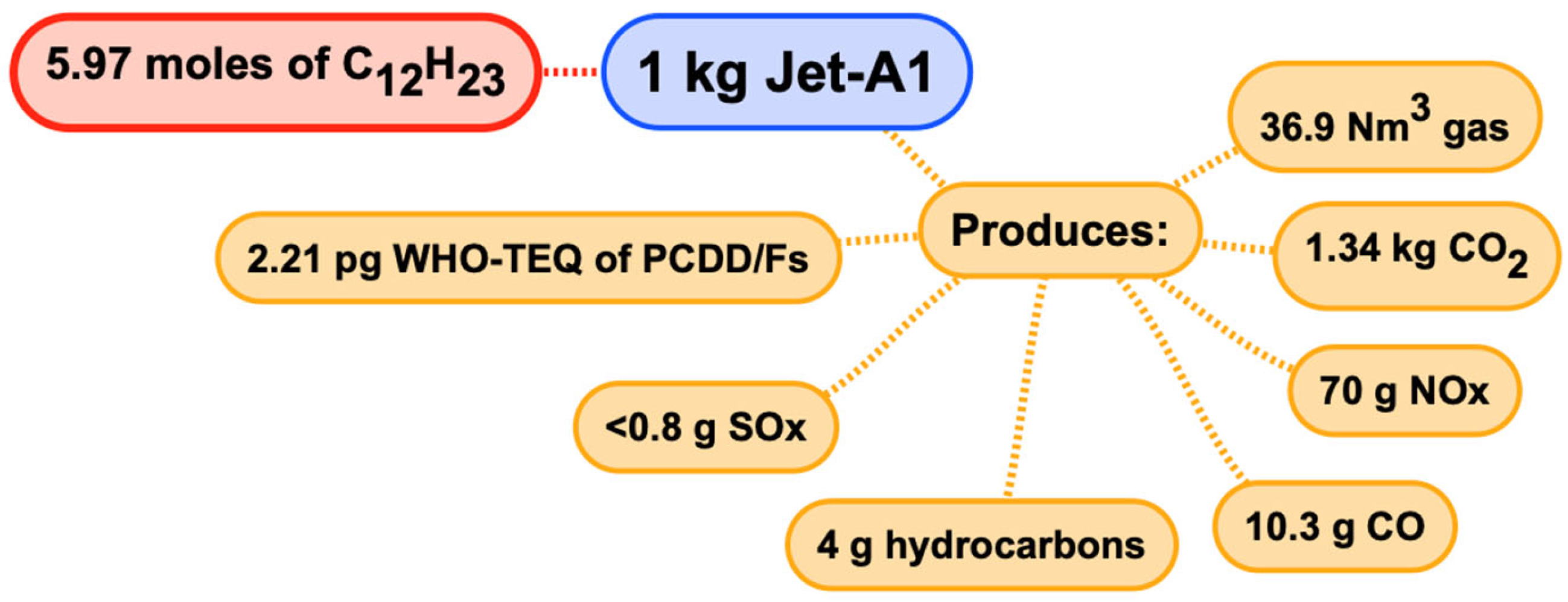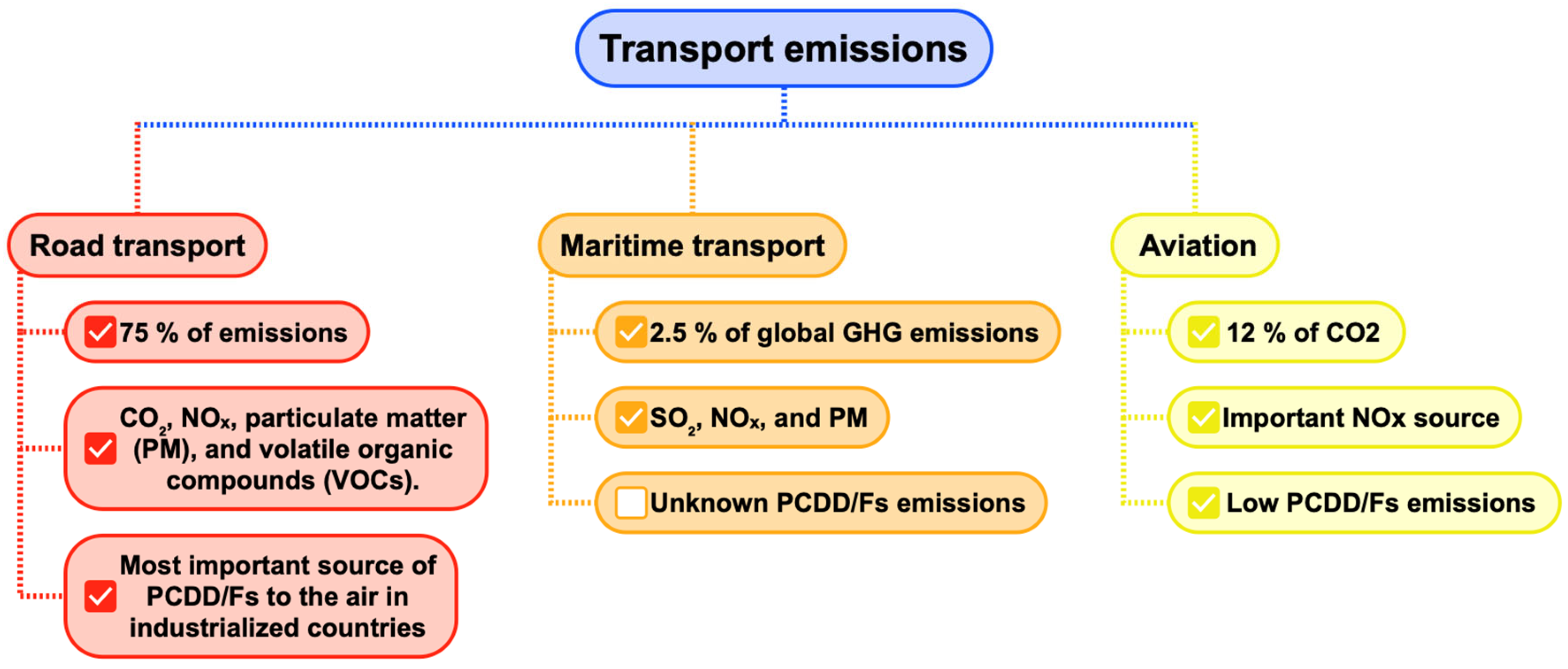The Contribution of Commercial Flights to the Global Emissions of Inorganic and Organic Pollutants
Abstract
1. Introduction
2. The Role of Aviation Emission Regulators
3. Data on Emissions of Pollutants from Global Aircraft Activity
3.1. General View
3.2. Data on Emissions
- Homogeneous Formation: This occurs in the gas phase at high temperatures (500–800 °C). It involves the pyrolytic rearrangement of chlorinated precursors like chlorophenols and chlorobenzenes [14].
- Heterogeneous Formation: This takes place at lower temperatures (200–400 °C) on the surface of particles such as ash or soot. It is a catalyzed reaction involving the oxidation and chlorination of unburned carbon in the particulates [14].
- De Novo Synthesis: This mechanism involves the formation of dioxins from carbonaceous particles in the presence of chlorine. It typically occurs at temperatures between 200 and 400 °C and is catalyzed by metals like copper. The process includes the oxidation and chlorination of carbon structures, leading to the formation of PCDD/Fs [15].
4. Comparing Aviation Emissions with Other Transport Sectors
4.1. Total Emissions by Sector
4.2. Trends and Future Projections
5. Conclusions
Author Contributions
Funding
Data Availability Statement
Conflicts of Interest
References
- Bendtsen, K.M.; Bengtsen, E.; Saber, A.T.; Vogel, U. A Review of Health Effects Associated with Exposure to Jet Engine Emissions in and around Airports. Environ. Health 2021, 20, 10. [Google Scholar] [CrossRef] [PubMed]
- Wilkerson, J.T.; Jacobson, M.Z.; Malwitz, A.; Balasubramanian, S.; Wayson, R.; Fleming, G.; Naiman, A.D.; Lele, S.K. Analysis of Emission Data from Global Commercial Aviation: 2004 and 2006. Atmos. Chem. Phys. 2010, 10, 6391–6408. [Google Scholar] [CrossRef]
- Conesa, J.A.; Ortuño, N.; Palmer, D. Estimation of Industrial Emissions during Pyrolysis and Combustion of Different Wastes Using Laboratory Data. Sci. Rep. 2020, 10, 6750. [Google Scholar] [CrossRef] [PubMed]
- Bo, X.; Xue, X.; Xu, J.; Du, X.; Zhou, B.; Tang, L. Aviation’s Emissions and Contribution to the Air Quality in China. Atmos. Environ. 2019, 201, 121–131. [Google Scholar] [CrossRef]
- Liu, H.; Tian, H.; Hao, Y.; Liu, S.; Liu, X.; Zhu, C.; Wu, Y.; Liu, W.; Bai, X.; Wu, B. Atmospheric Emission Inventory of Multiple Pollutants from Civil Aviation in China: Temporal Trend, Spatial Distribution Characteristics and Emission Features Analysis. Sci. Total Environ. 2019, 648, 871–879. [Google Scholar] [CrossRef] [PubMed]
- Durdina, L.; Brem, B.T.; Setyan, A.; Siegerist, F.; Rindlisbacher, T.; Wang, J. Assessment of Particle Pollution from Jetliners: From Smoke Visibility to Nanoparticle Counting. Environ. Sci. Technol. 2017, 51, 3534–3541. [Google Scholar] [CrossRef] [PubMed]
- EDGAR—The Emissions Database for Global Atmospheric Research. Available online: https://edgar.jrc.ec.europa.eu/ (accessed on 15 January 2025).
- European Environment Agency’s Home Page. Available online: https://www.eea.europa.eu/en (accessed on 15 January 2025).
- Sustainable Aviation Fuels in Practice Main Milestones so Far. Available online: https://www.iata.org/en/iata-repository/pressroom/fact-sheets/fact-sheet-sustainable-aviation-fuels/ (accessed on 15 January 2025).
- Spicer, C.; Holdren, M.; Lyon, T.; Riggin, R. Composition and Photochemical Reactivity of Turbine Engine Exhaust. 1984. Available online: https://ww2.arb.ca.gov/sites/default/files/2023-12/spicer_turbine_1984.pdf (accessed on 18 March 2025).
- Masiol, M.; Harrison, R.M. Aircraft Engine Exhaust Emissions and Other Airport-Related Contributions to Ambient Air Pollution: A Review. Atmos. Environ. 2014, 95, 409–455. [Google Scholar] [CrossRef] [PubMed]
- Stockholm Convention—Home Page. Available online: https://www.pops.int/ (accessed on 15 January 2025).
- Conesa, J.A. Sewage Sludge as Inhibitor of the Formation of Persistent Organic Pollutants during Incineration. Sustainability 2021, 13, 10935. [Google Scholar] [CrossRef]
- Stanmore, B.R. The Formation of Dioxins in Combustion Systems. Combust. Flame 2004, 136, 398–427. [Google Scholar] [CrossRef]
- Huang, H.; Buekens, A. On the Mechanisms of Dioxin Formation in Combustion Processes. Chemosphere 1995, 31, 4099–4117. [Google Scholar] [CrossRef]
- Agrawal, H.; Sawant, A.A.; Jansen, K.; Wayne Miller, J.; Cocker, D.R. Characterization of Chemical and Particulate Emissions from Aircraft Engines. Atmos. Environ. 2008, 42, 4380–4392. [Google Scholar] [CrossRef]
- Impactará Precio del Petróleo a La Demanda de Turbosina|Aviación 21. Available online: https://a21.com.mx/index.php/aeronautica/2024/08/16/impactara-precio-del-petroleo-la-demanda-de-turbosina?utm_source=chatgpt.com (accessed on 21 January 2025).
- Los 10 Aviones Comerciales Más Usados—IASCA. Available online: https://iasca.aero/los-10-aviones-comerciales-mas-usados/ (accessed on 20 January 2025).
- Masiol, M.; Mallon, T.M.; Haines, K.M.; Utell, M.J.; Hopke, P.K. Source Apportionment of Airborne Dioxins, Furans, and Polycyclic Aromatic Hydrocarbons at a United States Forward Operating Air Base during the Iraq War. J. Occup. Environ. Med. 2016, 58, S31–S37. [Google Scholar] [CrossRef] [PubMed][Green Version]
- Quaß, U.; Fermann, M.; Bröker, G. The European Dioxin Air Emission Inventory Project—Final Results. Chemosphere 2004, 54, 1319–1327. [Google Scholar] [PubMed]
- Tesseraux, I. Risk Factors of Jet Fuel Combustion Products. Toxicol. Lett. 2004, 149, 295–300. [Google Scholar] [PubMed]
- Song, S.; Chen, K.; Huang, T.; Ma, J.; Wang, J.; Mao, X.; Gao, H.; Zhao, Y.; Zhou, Z. New Emission Inventory Reveals Termination of Global Dioxin Declining Trend. J. Hazard. Mater. 2023, 443, 130357. [Google Scholar] [CrossRef] [PubMed]
- International Civil Aviation Organization (ICAO). Available online: https://www.icao.int/Pages/default.aspx (accessed on 15 January 2025).
- Janicka, A.B.; Zawiślak, M.; Gawron, B.; Górniak, A.; Bialecki, T. Emission of Volatile Organic Compounds during Combustion Process in a Miniature Turbojet Engine. Environ. Prot. Eng. 2018, 44, 57–67. [Google Scholar] [CrossRef]
- Rey, M.D.; Font, R.; Aracil, I. PCDD/F Emissions from Light-Duty Diesel Vehicles Operated under Highway Conditions and a Diesel-Engine Based Power Generator. J. Hazard. Mater. 2014, 278, 116–123. [Google Scholar] [CrossRef] [PubMed]
- Smit, R. Dioxins Emissions from Motor Vehicles in Australia; Australian Government Department of the Environment and Heritage: Canberra, Australia, 2004; ISBN 064254994X.
- Kulkarni, P.S.; Crespo, J.G.; Afonso, C.A.M. Dioxins Sources and Current Remediation Technologies—A Review. Environ. Int. 2008, 34, 139–153. [Google Scholar] [CrossRef] [PubMed]




| Ranking | Maker | Model | Production Years | Number of Passengers (Approx.) | Fuel Capacity (L) | Maximum Speed (Mach) | Autonomy (km) |
|---|---|---|---|---|---|---|---|
| 1 | Boeing | 747 | 1969–2005 | 366 | 243,120 | 0.92 | 14,816 |
| 2 | Boeing | 777 | 1995–now | 440 | 181,283 | 0.84 | 17,370 |
| 3 | Boeing | 737 | 1967–now | 170 | 29,660 | 0.78 | 7223 |
| 4 | Boeing | 787 | 2009–now | 350 | 101,350 | 0.84 | 14,075 |
| 5 | Boeing | 757 | 1982–2004 | 270 | 43,400 | 0.80 | 7222 |
| 6 | Boeing | 767 | 1982–now | 375 | 61,800 | 0.69 | 11,093 |
| 7 | Boeing | 727 | 1963–1984 | 190 | 15,000 | 0.67 | 5000 |
| 8 | Airbus | A320 | 1984–now | 220 | 27,200 | 0.71 | 6100 |
| 9 | Boeing | 707 | 1954–1978 | 190 | 90,290 | 0.71 | 10,500 |
| 10 | Airbus | A380 | 2005–2021 | 853 | 320,000 | 0.96 | 15,200 |
Disclaimer/Publisher’s Note: The statements, opinions and data contained in all publications are solely those of the individual author(s) and contributor(s) and not of MDPI and/or the editor(s). MDPI and/or the editor(s) disclaim responsibility for any injury to people or property resulting from any ideas, methods, instructions or products referred to in the content. |
© 2025 by the authors. Licensee MDPI, Basel, Switzerland. This article is an open access article distributed under the terms and conditions of the Creative Commons Attribution (CC BY) license (https://creativecommons.org/licenses/by/4.0/).
Share and Cite
Conesa, J.A.; Mortes, J. The Contribution of Commercial Flights to the Global Emissions of Inorganic and Organic Pollutants. Processes 2025, 13, 995. https://doi.org/10.3390/pr13040995
Conesa JA, Mortes J. The Contribution of Commercial Flights to the Global Emissions of Inorganic and Organic Pollutants. Processes. 2025; 13(4):995. https://doi.org/10.3390/pr13040995
Chicago/Turabian StyleConesa, Juan A., and Jonathan Mortes. 2025. "The Contribution of Commercial Flights to the Global Emissions of Inorganic and Organic Pollutants" Processes 13, no. 4: 995. https://doi.org/10.3390/pr13040995
APA StyleConesa, J. A., & Mortes, J. (2025). The Contribution of Commercial Flights to the Global Emissions of Inorganic and Organic Pollutants. Processes, 13(4), 995. https://doi.org/10.3390/pr13040995








